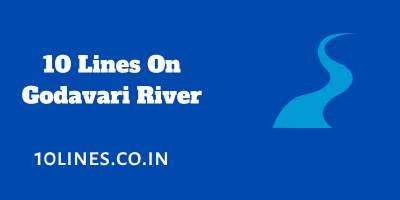10 Lines On Godavari River Are you trying to find a ten-line article on India’s most famous river, the Godavari? Are you a high school or college student? Here are three lists of the Godavari River. The three lists are made for Children, schoolchildren, and high school students.

10 Lines On Godavari River For Children And Students
Here, you can find good info about its location, dimensions, tributary rivers, cultural significance, and other specifics.
Godavari is one of the vital rivers in the southeast and central regions of India rises in Trimbakeshwar and flows 1465 km longer to meet the Bay of Bengal. It is also known as the “Ganga of South India” and is a monsoon-fed river. The river adds great importance to the cities which are on the bank of the Godavari River.
If you want to learn more about the revered river Godavari, it is a good idea to read the entire article.
Set 1] 10 Lines On The Godavari River For Children:
1] The Godavari River flows through India’s southeast and central regions.
2] Dakshin Ganga and Gautami are two other names for the holy river.
3] It rises in Trimbakeshwar and flows into the Bay of Bengal.
4] Godavari flows 1465 km longer and has a basin that is 312,812 sq.km larger.
5] The river divides into the Gautami Godavari and the Vasishta Godavari before draining into the Gulf of Bengal.
6] The main cause of flooding in the Godavari River is strong rainfall during the monsoon season.
7] The well-known Gnana Saraswati Temple of Goddess Saraswati is located on Godavari’s bank.
8] Simhastha Kumbh mela is a well-known pilgrimage that occurs once every 12 years at the Godavari River.
9] The pollution of the Godavari River is mostly due to an increase in industrial solid waste and effluents.
10] Coringa Wildlife Sanctuary is a bird sanctuary located on the banks of the Godavari River.
Set 2] 10 Lines On The Godavari River For School Students:
1] The sacred Godavari River is the greatest river in the Indian Peninsula.
2] Godavari is a holy river for Hindus, hence there are various religious temples near the riverbank.
3] The Godavari River originates in the Trimbakeshwar area of Maharashtra.
4] Godavari is the country’s second-largest basin, accounting for around 9.5% of the total land area of the nation.
5] The Godavari River has several significant tributaries, including the Pravara, Purna, Pranhita, Maner, Indravathi, and Manjira.
6] The Godavari is the second longest river in India where the Ganga is in first position.
7] The Godavari River is not a transboundary river because it only runs through Indian states.
8] Nashik, Nagpur, Mancherial, Ramagundam, Narsapur, Seoni, and Balaghat are a few of the well-known cities close to the Godavari basin.
9] In Maharashtra, there is a sacred temple known as “Trayambakeshwar Jyotirlinga” on the banks of the Godavari.
10] The Godavari River is a lifeline for its residents, who rely on it for a living.
Set 3] 10 Lines On The Godavari River For College Students:
1] The Godavari River, sometimes known as the “Ganga of South India” or “Dakshin Ganga,” is India’s second-largest river.
2] This river runs across four Indian states: Maharashtra, Telangana, Chhattisgarh, and Andhra Pradesh.
3] The Godavari River originates in Trimbakeshwar, a location in the Nashik district 80 kilometers from the Arabian Sea.
4] There are numerous hydroelectric power plants that use the Godavari river’s water to produce massive amounts of electricity.
5] The river is very religiously significant in Hinduism culture, hence there are many religious sites around the river’s bank.
6] Trimbakeshwar, which lies close to the Godavari River, is one of the places where the Kumbh Mela is held.
7] Excellent agricultural land can be found along the banks of the Godavari River due to the soil’s high aluminum content.
8] The Godavari delta, generated by the Godavari River, is a fertile region that is perfect for agriculture.
9] Under the National River Conservation Plan, the Indian government is taking action to prevent Godavari River pollution.
10] Some part of the Godavari River is considered a part of the national waterway NW4.
Friends, thank you for reading “10 Lines on the Godavari.” We sincerely hope that you will find the information above useful. This information was presented in an effort to be clear and simple to remember. You can use this information to get ready for assignments, projects, and presentations.